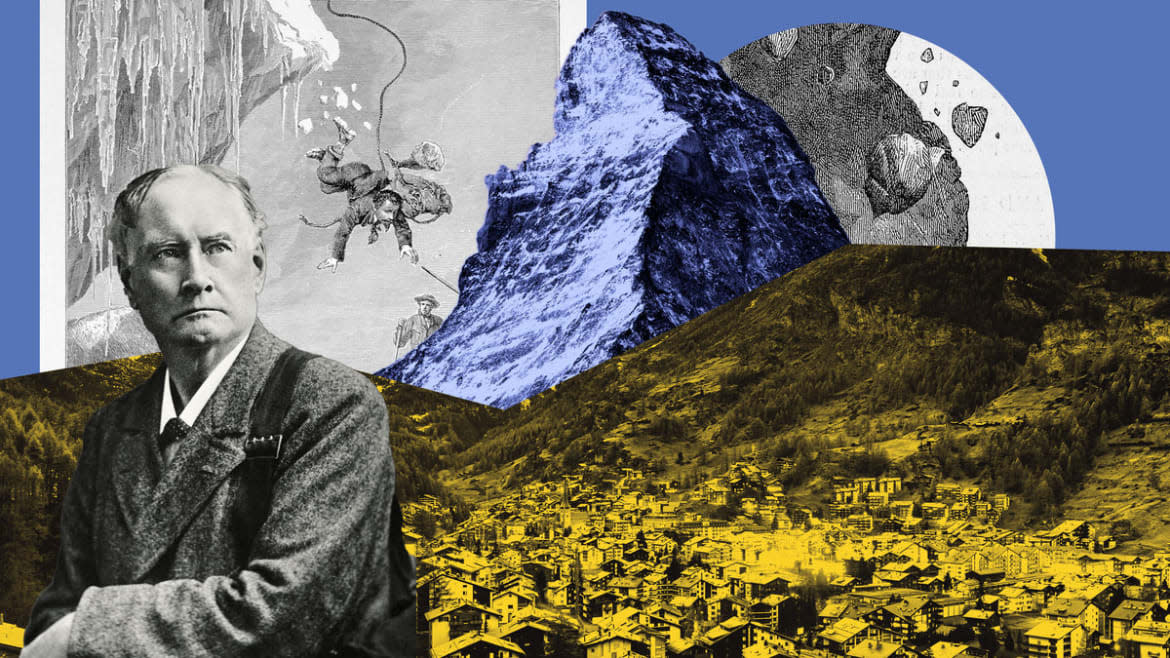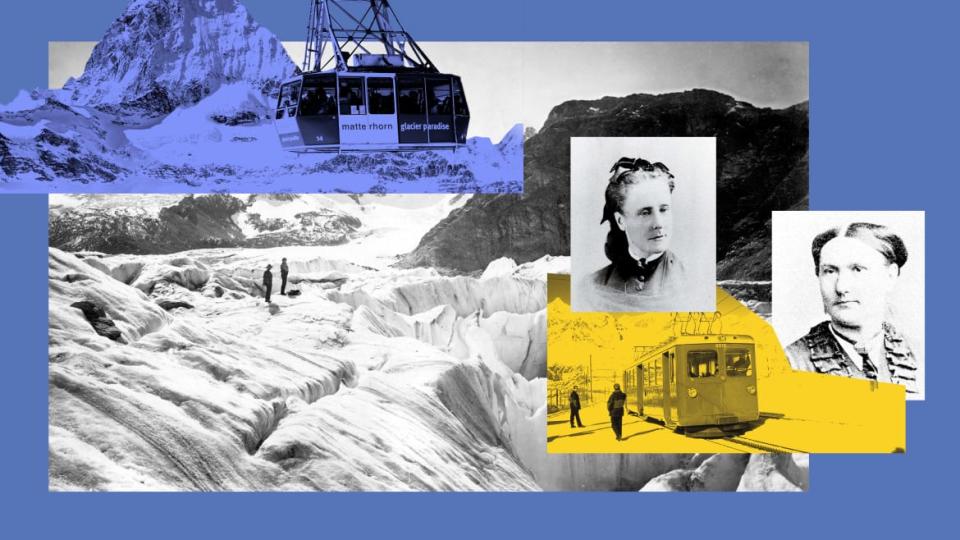The Tragedy That Made This Glitzy Swiss Village Famous

- Oops!Something went wrong.Please try again later.
“Who doesn’t know the Matterhorn?”
I was enjoying a scrumptious meal at Madre Nostra, an Italian restaurant in a gorgeously restored chalet in Zermatt, as Janine Imesch, my table-mate, pondered why it is that people around the world can instantly recognize the iconic Swiss peak. Until the late 19th century, no one knew the Matterhorn, no one knew Zermatt, said the former marketing director of Tourism Zermatt. At the time, Zermatt was like any other village in the Swiss Alps: a poor agricultural village. “How come everyone can instantly recognize the Matterhorn when they see a photo?” she went on. “The Matterhorn isn’t even the highest mountain in Switzerland. So how did Zermatt become so famous?” She paused for dramatic effect. “It’s because of a tragedy.”
It’s hard to imagine that an attractive, lively town as famous as Zermatt, surrounded as it is by an arrestingly beautiful alpine panorama, could have initially become world-famous because of a dreadful misfortune. Ambling along the Bahnhofstrasse, the narrow main street, which is lined with stylish hotels, ski shops, luxury watch boutiques, cozy restaurants, and aromatic bakeries and konditorei (sweet shops), it’s easy enough to overlook.
Zermatt was put on the map thanks—or no thanks, depending on how you look at it—to British mountaineer Edward Whymper. The Matterhorn was considered “the most thoroughly inaccessible of all mountains,” Whymper wrote in his memoir, Scrambles Among the Alps. It was one of the last peaks in the Swiss Alps that had not yet been summited, and Whymper was determined to do so. On July 14, 1865, after seven failed attempts, Whymper, along with six other climbers, reached the top. The men were victorious.
But, then, only an hour later, triumph turned to tragedy. As the seven men began their descent, one of them slipped and the rope that was tying the climbers together snapped. Four of the original seven fell to their deaths.
The catastrophe is recounted in the Matterhorn Museum. The tiny Matterhorn-shaped glass structure standing in the town square is deceiving since from the outside it appears to contain only a ticket booth and gift shop. But, invisible from above, the museum holds a subterranean recreation of an alpine village that includes a town square, a vicarage, a barn, a tea house, and a mountain guide’s home. Zermatt’s history as an alpinists’ destination is told here, along with the story of the ill-fated first ascent of the Matterhorn by Whymper and his men, complete with the torn rope, which is displayed in a glass case.
The museum also highlights the achievements of women: Lucy Walker, who, in 1871 and wearing a long flannel skirt, was the first woman to reach the summit, and Meta Brevoort, who, also in 1871, was the first to traverse the mountain from Zermatt to Breuil, on the Italian side.
Those especially preoccupied with Zermatt’s early climbing history can also stop by the mountaineers’ cemetery in the town center, a moving reminder of lives lost and alpinism dreams forsaken. About 50 climbers from the late 19th and early 20th Century are buried here.
After the calamity surrounding the first ascent, Zermatt became an overnight celebrity. As news of the terrible accident spread around the globe, people wanted to see—or climb for themselves—the 14,691-foot-high mountain that had killed four mountaineers, not on their way up but on their way back down. The village rushed to build more hotels to accommodate the sudden influx of new tourists.

From left to right: Matterhorn glacier paradise, Gorner glacier, Gornergrat Railway, Meta Brevoort, and Lucy Walker
Today, people still travel to Zermatt to climb the Matterhorn but the town is now much better known as a glitzy year-round, world-class ski resort. The only sign of this prosperous town’s peasant past is the historic wooden grain storage sheds, known as “spychers,” sprinkled around town and up the mountain slopes.
Over 2 million overnight guests descend on Zermatt each year, with another million day visitors, making the permanent population of 5,424 appear much greater. The town is home to 107 hotels, as well as other types of accommodation such as a backpacker lodge, mountain huts, and visitor apartments. With 118 restaurants, 15 mountain hut restaurants, and 59 bars, there is no lack of dining and drinking options here.
Indeed, Zermatt has gained a reputation as the foodie capital of the Swiss Alps, boasting two Michelin-starred restaurants and no fewer than 20 that have been awarded chef’s toques by the prestigious Gault-Millau gastronomy guide. Impressively, six of these Gault-Millau eateries are mountain huts, including the beloved Chez Vrony, a local institution for over 100 years, courtesy of its top-drawer cuisine, gorgeous decor, and enviable view of the Matterhorn from its popular terrace.
In winter, skiers and snowboarders in Zermatt benefit from 217 miles of ski pistes, which includes Cervinia on the Italian side. Non-skiers can also take advantage of the snowshoe and cross-country ski trails or try their hand at tobogganing Swiss-style—on raised wooden sleds with steel runners underneath the legs. There are three dedicated toboggan runs in the area, the Rotenboden/Gornergrat one being the highest in the Alps as well as one of the most panoramic, but not as long or steep as the Täsch run.
Besides superlative skiing, Zermatt draws outdoor sports and nature enthusiasts in all seasons. In summer, mountain bikers can ride 125 miles of biking trails. Hikers, for their part, can take advantage of a 250-mile trail network, 30 of which can be walked in winter. Lovers of mountain wildflowers should try the Rotenboden-Gornergrat hiking trail over the lateral moraine of the Gorner glacier. This area is the best in Zermatt for observing alpine flowers. Edelweiss, gentian, and alpine roses can be found here, in addition to flowers that are endemic to the Zermatt area and cannot be found anywhere else.
One popular activity in Zermatt that does not require much physical effort is taking the electric-powered Gornergrat train up to the top of the Gornergrat, a rocky ridge overlooking the Gorner Glacier. The train ride from Zermatt to the top of the Gornergrat offers spectacular views of the Matterhorn and the Gorner Glacier, the third longest in Switzerland. The summit is also home to the Kulm Hotel Gornergrat, the highest hotel in Switzerland at 10,170 feet, and the Stellarium, a scientific research center used by the universities of Bern and Geneva.
Also of interest to tourists is riding the cable car up to the Matterhorn Glacier Paradise. At 12,739 feet, Glacier Paradise is Europe’s highest mountain station. Those who want to soar even higher can take the summit lift from here up to the 360-degree viewing platform. Glacier Paradise also counts an ice palace, cinema, and restaurant.
On the day I was meant to go up to Glacier Paradise it was raining hard in Zermatt and there was a blizzard up at the top. The gondola operators were not permitted to take us further than the midway station, where I walked around in the snowstorm for a few minutes just to feel the crisp fresh air and the force of the wind blowing the snow around. It was a complete whiteout outside and I couldn’t see more than 10 feet ahead, but I found it beautiful and invigorating nonetheless. At one point I lost my balance on a downhill slope, my unsteady foot slipping underneath the security rope, and I was briefly reminded of Edward Whymper’s unfortunate companions who didn’t live to tell their tale of glory.
Back on the Bahnhofstrasse I purchased a box of Matterhörnli, handmade chocolates in the distinctive shape of the Matterhorn, a specialty from Fuchs, a beloved local bakery and chocolate shop. The chocolates were a gift to myself, an edible souvenir of the Matterhorn, one of the world’s most fabled mountains.
Get the Daily Beast's biggest scoops and scandals delivered right to your inbox. Sign up now.
Stay informed and gain unlimited access to the Daily Beast's unmatched reporting. Subscribe now.

